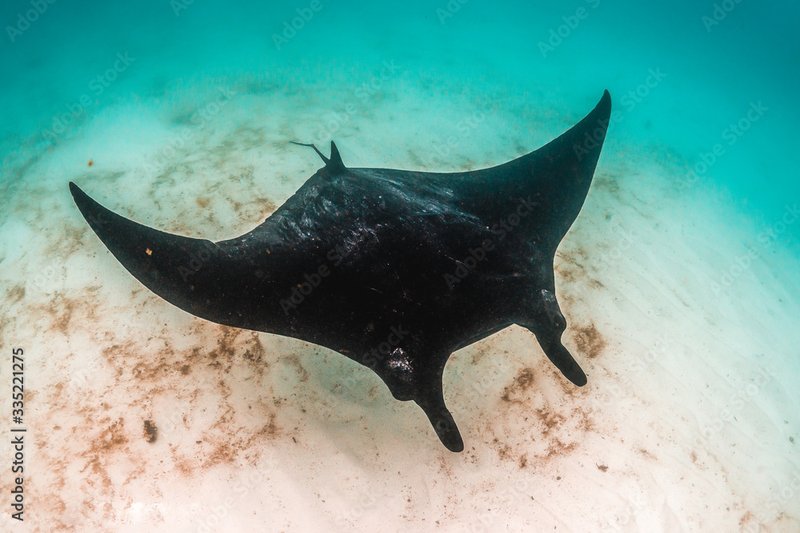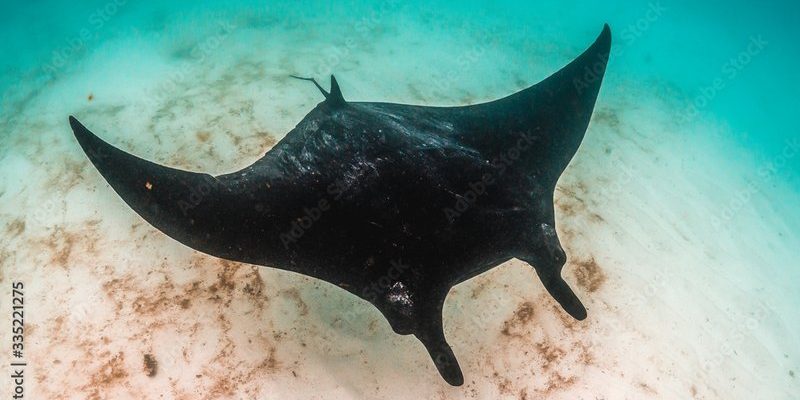
Manta rays are some of the most awe-inspiring creatures of the ocean. Imagine gliding through the water like a bird in the sky, their large, flat bodies gracefully soaring just below the surface. These gentle giants can reach impressive sizes, with some measuring up to 29 feet from wingtip to wingtip! What’s truly fascinating about manta rays is that they aren’t just beautiful; they play a crucial role in maintaining the health of marine ecosystems.
You might be wondering how such a large creature can be harmless, right? Well, manta rays feed primarily on plankton, tiny organisms that drift in the ocean. They use their gill rakers to filter these minuscule meals while swimming gracefully through the water. Let’s dive deeper into the world of manta rays and discover what makes them so captivating.
Manta Ray Species
Differences Between the Two Species
There are two primary species of manta rays: the Giant Manta Ray and the Reef Manta Ray. The Giant Manta Ray, as the name suggests, can grow much larger than its reef counterpart. This species typically swims in deeper waters, while the Reef Manta Ray prefers coastal areas, often found near coral reefs. Each species has unique behaviors and habitats, shaping their lives in fascinating ways.
The Giant Manta Ray, scientifically known as Manta birostris, can be found in tropical and subtropical waters across the globe. They are often seen migrating long distances in search of food or mating opportunities. On the other hand, the Reef Manta Ray, or Manta alfredi, tends to stay closer to shore. They are often observed in cleaning stations, where smaller fish eat parasites and dead skin off their bodies, creating a unique relationship between species.
Manta Ray Habitat
Manta rays thrive in warm, tropical oceans worldwide. You can find them in places like the Great Barrier Reef, the Maldives, and the waters around Hawaii. They prefer habitats rich in plankton, which are essential to their diet. The calm, clear waters of coral reefs provide an ideal environment for these creatures to hunt and socialize.
Interestingly, manta rays are sometimes seen in deeper waters, where they can dive as deep as 1,500 feet! However, they prefer to reside in the upper layers of the ocean, where light penetrates, making it easier for them to hunt for food. This habitat choice also helps them stay visible to potential mates during the breeding season.
Physical Characteristics
One of the most striking features of manta rays is their size. A Giant Manta Ray can weigh over 3,000 pounds and has a wingspan that can stretch nearly 30 feet! Their large pectoral fins resemble wings, allowing them to glide effortlessly through the water. The sleek and streamlined body helps them move gracefully, while their distinct coloration, often dark on top and lighter underneath, provides camouflage in the ocean.
Additionally, manta rays have unique facial characteristics. Their mouths, located on the underside of their bodies, can open wide to capture their food. They possess specialized gill rakers that filter plankton and small fish as they swim. These adaptations make them highly efficient feeders, able to consume large quantities of food even though they are gentle giants.
Behavior and Social Structure
Manta rays are incredibly social creatures. They often gather in groups, sometimes totaling up to 50 individuals, but this can vary based on the region and time of year. These aggregations provide many benefits, including enhanced foraging opportunities and increased chances of finding a mate.
You may also notice that manta rays are highly curious animals. They often approach divers and snorkelers, inspecting humans with their big, expressive eyes. This curiosity can create magical encounters, allowing us to appreciate these incredible creatures up close. Moreover, manta rays are known to engage in aerial displays, leaping out of the water and performing flips—a spectacle that leaves many observers in awe.
Diet and Feeding Habits
Manta rays are filter feeders, primarily consuming tiny organisms such as plankton, krill, and small fish. Their feeding technique is quite fascinating. As they swim, they open their mouths wide to take in large amounts of water, and their gill rakers trap the food while the water is expelled. This method allows them to efficiently capture a food source that is often too small to see with the naked eye.
During feeding, manta rays often congregate in areas with high concentrations of plankton, creating feeding frenzies that are a sight to behold. They can eat around 2,000 pounds of plankton in a single day! This incredible appetite plays a crucial role in maintaining marine ecosystems, as it helps control plankton populations and supports the food web in their habitats.
Reproduction and Lifespan
Reproduction in manta rays is fascinating, with females giving birth to live young. After a gestation period of about 12 months, a female manta ray will typically give birth to a single pup, although twins have been recorded. The pups are around 4 feet long at birth, and they quickly learn to swim and navigate their surroundings.
Manta rays are known to have a long lifespan, often living up to 50 years in the wild. However, this can vary based on environmental factors and threats. Their slow reproduction rate means that maintaining stable populations is critical, especially given the challenges they face from human activities.
Conservation Status
Sadly, manta rays face numerous threats, including habitat destruction, illegal fishing, and climate change. Due to their vulnerability and slow reproductive rates, both species of manta rays are listed as vulnerable or endangered by various conservation organizations. Protecting their habitats and creating marine protected areas are crucial steps to ensure their survival.
Many organizations are working tirelessly to raise awareness about the importance of manta rays in marine ecosystems and advocate for their protection. In recent years, some countries have implemented bans on fishing or harmful practices targeting these magnificent creatures, allowing populations a chance to recover. Educating people about the importance of manta rays can help foster a sense of stewardship and responsibility for our oceans.
Interesting Facts About Manta Rays
| Species | Giant Manta Ray (Manta birostris) | Reef Manta Ray (Manta alfredi) |
| Size | Up to 29 feet (8.8 meters) | Up to 18 feet (5.5 meters) |
| Weight | Up to 3,000 pounds (1,360 kg) | Up to 1,300 pounds (590 kg) |
| Diet | Plankton, small fish | Plankton, small fish |
| Lifespan | Up to 50 years | Up to 50 years |
| Habitat | Tropical and subtropical oceans | Coastal waters, coral reefs |
FAQ
What do manta rays eat?
Manta rays primarily feed on plankton and small fish. They are filter feeders, using their gill rakers to trap these tiny organisms while swimming through the water. They can consume impressive amounts, up to 2,000 pounds a day, especially during feeding frenzies when plankton is abundant.
Are manta rays dangerous to humans?
Manta rays are not dangerous to humans at all. They are gentle and curious creatures that pose no threat. In fact, they’re often described as friendly giants. They sometimes swim close to divers and snorkelers, which can lead to magical encounters.
How do manta rays reproduce?
Manta rays reproduce by giving birth to live young after a gestation period of about 12 months. Typically, a female will give birth to one pup, although twins have been reported. The newborns are around 4 feet long and begin swimming right away.
What is the lifespan of a manta ray?
Manta rays can live up to 50 years in the wild. However, their lifespan can be affected by various environmental factors and human-related threats, such as habitat destruction and fishing.
Where can I find manta rays?
Manta rays are found in tropical and subtropical waters around the world. Popular locations for observing them include the Great Barrier Reef, Hawaii, and the Maldives, where they often gather to feed or mate.
What threats do manta rays face?
Manta rays face numerous threats, including habitat destruction, illegal fishing, and climate change. Their slow reproductive rates make them vulnerable, and conservation efforts are essential to protect these magnificent creatures.
Can manta rays be kept in aquariums?
While some aquariums have attempted to keep manta rays, it’s important to note that they require large spaces and specific environmental conditions. Keeping them in aquariums can be challenging, and many facilities focus on conservation and education instead of maintaining them in captivity.
What unique behaviors do manta rays display?
Manta rays are known for their aerial displays, where they leap out of the water and perform flips. They also exhibit curious behavior, often approaching divers and snorkelers to investigate their presence. Their social nature leads them to gather in groups, particularly during feeding.
How can I help protect manta rays?
You can help protect manta rays by supporting conservation organizations, spreading awareness about their importance in marine ecosystems, and advocating for sustainable practices. Additionally, avoiding products that may contribute to ocean pollution and participating in beach clean-ups can contribute to healthier ocean environments.
What is a cleaning station for manta rays?
A cleaning station is a location where manta rays go to have parasites and dead skin removed by smaller fish. These symbiotic relationships are beneficial for both parties, as the smaller fish get a meal while manta rays receive a clean and healthy skin. It is a common sight at coral reefs where manta rays frequent.
Why are manta rays important to the ecosystem?
Manta rays play a crucial role in maintaining healthy marine ecosystems. As filter feeders, they help control plankton populations, supporting the food web. By doing so, they contribute to the overall balance of marine life, making them vital to ocean health and conservation efforts.

